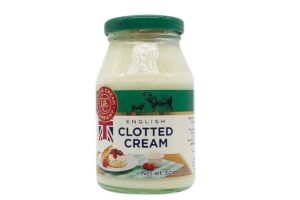Dive into the creamy world of clotted cream and Devonshire cream! Are they the same? Not quite. Let’s unravel the differences and similarities and discover the unique charms of these dairy delights.

Is Devonshire Cream the Same as Clotted Cream?
Devonshire cream and clotted cream may be used interchangeably, but they’re distinct.
Clotted cream, crafted from the rich milk of Jersey cows, undergoes a unique process involving overnight settling and warm incubation.
The result is a thick, yellowish-clotted layer with a slightly sour taste, favored as a topping for scones.
On the other hand, double Devon cream, the creamiest product from Devonshire Jersey cows, resembles butter in thickness and boasts a unique creamy flavor.
While some separation may occur in a jar, a swift stir restores it to a spreadable consistency.
Deciding between clotted cream and Devonshire cream comes down to personal taste. We lean towards clotted cream because it’s slightly sour and softer on scones, but we also enjoy the creamy delight of double Devon cream.
Give both a try on treats like crumpets, croissants, or English Muffins to discover your personal preference. Enjoy the taste test!
Clotted Cream vs Devonshire Cream: What’s the Difference?
Clotted cream vs Devonshire cream: they’re both rich and indulgent, but there’s a subtle difference.
Clotted cream is a West Country specialty, hailing from Cornwall and Devon in England. It’s made by heating rich cream until a layer of “clots” forms on the surface. The result is a thick, buttery cream with a golden crust.
Devonshire cream, on the other hand, is often used interchangeably with clotted cream, but some purists might argue.
Traditionally, Devonshire cream is simply a rich, thick cream from the county of Devon. However, it’s often similar to clotted cream in texture.
Now, let’s look closely at the differences between these two products:
1. Origin
Clotted cream originates from the West Country, specifically Cornwall and Devon in England. It’s a regional specialty with a distinctive production process.
Devonshire cream, on the other hand, hails from the county of Devon, but the term is often used more broadly to refer to a thick, rich cream.
2. Production Process
Clotted cream is made by heating rich cream until a layer of “clots” forms on the surface. This results in a thick, buttery cream with a golden crust.
Devonshire cream, on the other hand, is a rich, thick cream, and the specific production process may vary. It’s often similar to clotted cream in texture.
3. Texture
Clotted cream has a dense and thick consistency with a crusty layer on top, while Devonshire cream has a rich and thick texture, which can be similar to clotted cream.
4. Usage

Clotted cream is typically used as a topping for scones in the classic British cream tea. It can also be used in desserts and other culinary creations.
Devonshire cream is used similarly to clotted cream, often as a topping for scones or desserts.
5. Regional Variations
Clotted cream is associated with both Cornwall and Devon, but some might argue about the specific characteristics that make it “Cornish” or “Devonshire.”
Devonshire cream, on the other hand, reflects Devon’s cream tradition, and there may be local variations in production.
6. Terminology
Clotted Cream: The term is more specific and tied to the unique production method of forming clots during heating.
Devonshire Cream: The term is sometimes used interchangeably with clotted cream, but it can also refer more broadly to thick cream from Devon.
In the end, the choice between clotted cream and Devonshire cream may come down to personal preference, regional loyalty, or the specific characteristics you’re looking for in your indulgent cream experience!
What is Another Name for Clotted Cream?
Another name for clotted cream is Devonshire cream, often interchangeably called Devon cream. This indulgent dairy delight has a rich, velvety texture and a slightly sweet, buttery flavor.
Whether enjoyed atop scones, crumpets, or other treats, the luxurious taste of this product has made it a favorite in Devonshire, England, and beyond.
What Cream Can I Use Instead of Clotted Cream?
If clotted cream is out of reach, consider a couple of alternatives. Crème fraîche offers a similar silky, slightly nutty flavor, but with around 30% fat content, it’s lighter than clotted cream, lacking the rich, dense texture.
Mascarpone, with a fat content between 45-55%, comes closest to the luxurious texture of clotted cream. Although it’s a cheese rather than a cream, the flavors are surprisingly similar.
Greek yogurt is another clotted cream alternative. It has a thick and creamy texture, plus the tanginess can add a unique twist to your dish.
Related Questions
Why is Clotted Cream Illegal in the US?
Clotted cream isn’t actually illegal in the US. There might be some confusion around this. Indeed, traditional clotted cream from the UK may not be readily available in the US due to strict regulations on dairy imports, but it’s not illegal.
Some American dairies produce a similar product that complies with local regulations. So, no need to worry—enjoy your clotted cream if you can get your hands on it!
What is the American Equivalent of Clotted Cream?
Clotted cream is a bit unique, but if you’re looking for something similar in the US, you might want to try Devonshire cream or double cream.
While they’re not the same, they share a rich and thick consistency that can complement scones and desserts just as well.
What is Special About Devonshire Cream?

Devonshire cream, also known as clotted cream, is a thick and rich dairy product with a high-fat content.
It’s traditionally made by heating full-fat cow’s milk and allowing it to cool slowly, allowing the cream to rise to the top and form clots. These clots are then skimmed off to create clotted cream.
The unique texture and flavor of clotted cream come from this slow-cooking process, which gives it a slightly sweet, nutty taste and a dense, smooth consistency.
It’s a delightful accompaniment to scones, desserts, and other treats.
While Devonshire cream and clotted cream aren’t precisely the same thing, in many contexts, they’re used interchangeably, especially when served with tea and scones in the British tradition.
What is Clotted Cream Called in England?
In England, clotted cream is simply referred to as “clotted cream.” It’s a popular dairy product, especially in the West Country regions like Devon and Cornwall.
Clotted cream is commonly enjoyed with scones, jam, and tea in the traditional cream tea or afternoon tea setting.
Clotted Cream vs Devonshire Cream: Conclusion
In the creamy clash of clotted cream and Devonshire cream, the verdict is clear; both rich, both indulgent, yet distinctly different.
Whether you favor the slightly sour softness of clotted cream or the buttery thickness of Devonshire cream, the decision is personal.
From the West Country’s clotted cream with a golden crust to Devon’s creamy tradition, each boasts a unique story.
The choice, whether on scones or desserts, comes down to your taste preferences, regional loyalty, and the texture you crave.
So, enjoy the culinary journey, relishing the subtle differences between these dairy delights. In the end, whether it’s clotted cream or Devonshire cream, it’s all about savoring your indulgence.
